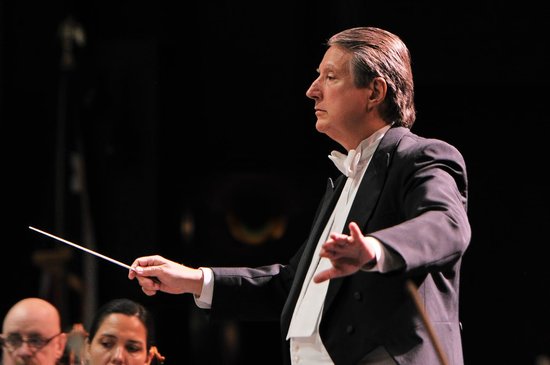A young violinist makes a fine showing in the Las Colinas Symphony’s trip to Vienna

Robert Carter Austin conducted the Las Colinas Symphony Orchestra in Irving Saturday night.
A young and — until now — largely invisible member of the first violin section of Las Colinas Symphony Orchestra took center stage in the orchestra’s season opener Saturday night, delivering an impressive, if self-effacing, performance of Bruch’s Violin Concerto No. 1 at Irving Arts Center under the baton of music director Robert Carter Austin.
Oleg Larshin played the opening theme of this well-known concerto with breadth and confidence before moving easily into the intricate and technically challenging trills and passagework of the second theme, all while maintaining striking musicality.

Oleg Larshin
The second movement — with its longing, Mahler-esque melody repeated through a series of emotion-laden modulations — was more evidence of his ability to make the violin sing with passionate expression. Larshin continued to demonstrate a powerful and convincing musicality and technical control — combined with a clean, clear timbre — in the final movement, with its alternations between folk-dance liveliness and moments of grandeur.
Larshin possesses most of the elements needed for a successful solo career and perhaps even stardom. (He also has diplomas from the Moscow State Conservatory and Michigan State University, and is currently a graduate student at Texas Christian University.) What’s missing at this point is a convincing stage presence. His manner was almost shy and distant. He tended to stare blankly at the floor during orchestral interludes. When he smiled, giving any sense that he noticed his audience, it was only during the final round of applause.
The orchestra under conductor Austin provided a solid collaboration for Larshin; contrary to usual practice in major orchestras of reducing the strings for this concerto, Austin kept the entire entourage of violins, violas, cellos and basses (listed in the program at sixty-three members) onstage to emphasize the concerto’s romantic grandeur. Austin has built an ensemble with a neat precision and clean, attractive tone, and he clearly owns a strong sense of timing and pacing, which is particularly important in the lyrical transformations of Bruch’s reflective but passionate middle movement.
Although Bruch is more closely identified with Berlin, the rest of this concert was largely devoted to the most Viennese of composers, the Strauss family of waltz fame as well as some of their contemporaries. In lieu of program notes, conductor Austin delivered succinct and occasionally humorous commentary from the stage, providing a glimpse of the waltz and operetta culture that coexisted with major serious composition in Vienna in the nineteenth and early twentieth centuries.
Von Suppé’s Overture for Morning, Noon, and Night in Vienna opened the concert, preceding the Bruch Concerto. Principal cellist Laura Ospina provided the poetry in her extended solo here, in the midst of the otherwise cheerfully rambunctious work. After the concerto and intermission, Austin and the orchestra turned to Johann Strauss II’s Vienna Blood Waltz, in which Austin demonstrated an ideal touch of rubato for these infectiously melodic dance tunes; the same composer’s jaunty polka There’s Only One Emperor City, There’s Only One Vienna, with its subtle quote from the old Austrian Imperial Anthem (known unfortunately also today as “Deutschland Über Alles”), followed, with its assertive, percussion-driven momentum.
A quick trip into the twentieth century, in the form of the overture to Countess Maritza by Austro-Hungarian Emmerich Kálmán, provided a jazzy interlude before more nineteenth-century polkas and waltzes by Johann Strauss II’s brother, Edward, and finally, the waltz king’s own Emperor Waltzes — a step up with the sophisticated harmonies and melodies of that composer’s final years. The paterfamilias also provided the encore in the form of the Radetzky March, with the obligatory clapping along from the audience.
Along with Austin’s obvious conducting skills and the resulting fine, clean performances by this orchestra, the Carpenter Performance Hall at Irving Arts Center, at just over 713 seats, provides an almost ideal venue for performance of major symphonic works by this ambitious and sturdy orchestra, which continues to bring fine performances to the northern suburbs of Dallas.
Las Colinas Symphony Orchestra’s “Vienna: City of Music” continues on Nov. 18 with Mozart, Haydn and Beethoven. lascolinassymphony.org.